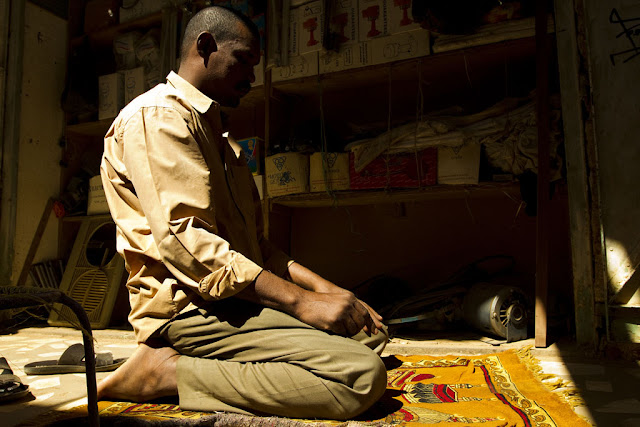 |
| 1A |
 |
| 1B |
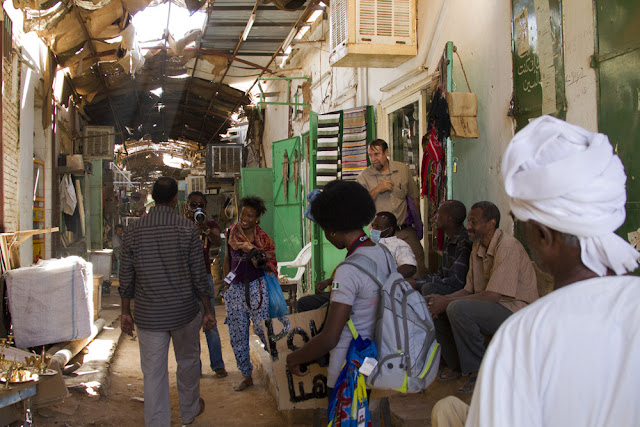 |
| 1C |
 |
| 1D |
 |
| 1E |
 |
| 1F |
1A – Nana interviews Issam Hafiez, veteran Sudanese artist and photographer.
1B – Our second work session in Omburman market. As was commonplace, one of the active members of the Sudanese Photographers joined us. Here with Emeka and myself is Yassir Bukhari.
1C – At work at the Omburman market; notice Jumoke’s smile, Emeka’s confident pose while he filmed, and Kemi’s possessive gait as she holds her customized poster.
1D – Who knows what Emeka is seeing behind the camera?
1E – I tell the truth, we were show offs in Khartoum! Interestingly, our show-off was often pre-empted by the smiles and accommodative gestures of the people we met on the road.
1F - The ladies prepare for the work/walk.
Alliances
There is the danger of mouth-only wishing for the creation of artistic highways across Africa. Khartoum ensured that we broke out into practical affirmation of our goal – we met a good number of artists, many of whom were enthusiastic about our project, and were more than willing to do more post-Invisible Borders. What is interesting, in addition, is that we made alliances with non-artists, as well, including an employee of the United Nations (Cage Banseka), who gave an interesting perspective into his work as a mediator between rebel groups and the Sudanese government; and with whom we had a long conversation on the work of the Chinese in Africa.
This postcard is a form of salute to the moments shared with several good people in Khartoum, and I apologize on the group’s behalf if any name is unmentioned – Faisal Mohammed Zahran, Mohad Al-Badawi, Soleyma Osman, Yassir Bukhari, Rayan Mohamed, Malaz Otaiby, Dia Khalil, and Mohammed El-Toum. I am certain Nana has her list of those who made her work worthwhile, and these brackets (…), however unconventional, are a tribute to Nana’s friends.
 |
| 2A |
 |
| 2B |
 |
| 2C |
 |
| 2D |
 |
| 2E |
 |
| 2F |
2A – With Isma’il Kush Kush, freelance journalist with CNN.com
2B – Smiles and shadowy reflections at the workshop with Sudanese Photographers.
2C – I cannot help myself: Attending a press conference that ended with about five people, aside members of the team, was not exciting, at all. Especially because we had spent almost all day preparing for the presentation at the Press Conference. Ala felt slighted by the failure of many invitees to turn up, especially government people. There is similar experience everywhere, we said, and it seems banal and verbose to repeat the obvious fact that few governments seem interested in solidifying their respective art institutions.
That said, there is the flip side of having an empty hall while we spoke about Invisible Borders. The metaphor can never be more apt, as the shadows of empty rooms and halls often seek to blur the reality that lies aside those shadows. Eliot: “Between the dreams and reality lies shadows.” I am continually given to convincing empty halls until the essence of our quest is ready for a pack-full hall.
2D – At the Goethe Institut. We are listening to Talal Afifi speak about the Sudan Film Factory, which I hope to attend soon – as is evident, I have begun to hold cameras.
2E – Our last night at Khartoum with friends we made, after dinner at Soleyma Osman’s invitation.
2F – Faisal Zahran, Sudanese model and photographer, and one of our favourite friends.
Postcards 1 – On Seeing Sufi
There is no way to forget our encounter with Sufism, and the colour that rushed into our eyes, and souls. Aside the colour of the gowns worn – mostly red, green, and white – there was the exotic and shameless dancing, singing, praying, and praise. Allah was the subject to whom the display was directed to, and I hope he hears.
There were hundreds of people that Friday, who gathered around a circle. In the circle, the Sufists converged barefooted. It must be a taboo for anyone to enter with shoes, as well as any woman to worship in the circle (Nana was almost beaten out of the circle when she entered). The worshippers danced mostly by bowing their heads and bending down to their waists. There were those who joined them outside the circle, those for whom the ritual seemed fascinating, or perhaps they were would-be Sufists.
Sufism is a practiced mostly in Islamic countries. But there are also Sufists in Ethiopia; interestingly, the only difference between those in Sudan and those in Ethiopia is the fact that the latter hold crosses while worshipping. The dance, singing and spiritual ecstasy are identical. Which makes me question whether Sufism is more than a religious practice, if it has some cultural twist, as well. Certainly, religion is inalienable from culture, even more because worship shapes outlook, and collective outlook is a synonym for culture.
Our place in the Sufistic circle was primarily to photograph and record the worship and the adherents. It surprised me a little that the Sufists were not, in any way, camera-shy. Emeka, Ala and Faisal joined in the circle, taking off their shoes first. None of them were accosted. (I must say that I am not used to a public display of worship or adherence – but I probably lie because I attend big churches where cameras trail the preacher and the crowd, usually for display on TV that reaches a wide audience.) There are those who might consider it vain for Sufists to let in cameras into their worship, or even to play their music over a loudspeaker. A comparison might be made with Francisian monks, especially because of the similarity in abhorrence for worldly goods and material. A rebuttal could be the fact that religion, as a subset of culture, is bound to change. But how much change is permissible, or worthy of the religion’s ideals, is a question that would stretch the argument further.
I could be tempted to consider Sufism as less than Christianity, and to seek only a touristical enjoyment of the dance, music and worship. But to do that to alienate myself from the spiritual quest of the Sufist adherents, is to be guilty of pitiless condescension, a crime against the soul and conscience of humanity.
 |
| 3A |
 |
| 3B |
 |
| 3C |
3A – Such brotherliness!
3B – Worship mode
3C – Emeka, in action, right in the ‘spiritual’ circle
Postcards 2 – Timeout with Nomads
En route the Sudanese-Ethiopian border, between Al-Gadarif city and Al-Gadamabat town, we stopped and had a beautiful interaction with the nomads who tended their sheep, donkeys, and camels. Our interaction with the nomads was important on many fronts – most importantly, I think of that meeting as an actualization of our interest in blurring borders. As is evident from the photos, in those few minutes, we introduced (to borrow Nana’s words) a ‘poetic stillness’ into the world of the nomads, for our sake, and theirs too. For our sakes because it was a different life and viewpoint from what we had seen at Khartoum. And for their sakes because in that brief moment, they saw the world through our eyes, and our work.
 |
| 3D |
 |
| 3E |
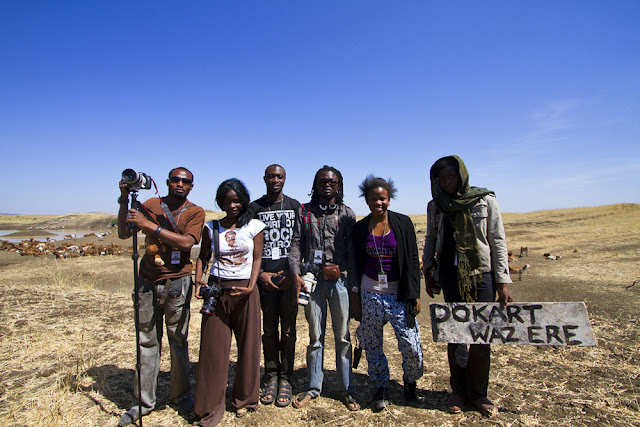 |
| 3F |
 |
| 3G |
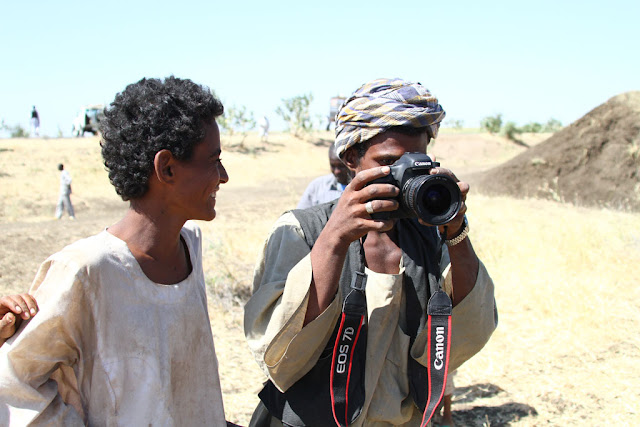 |
| 3H |
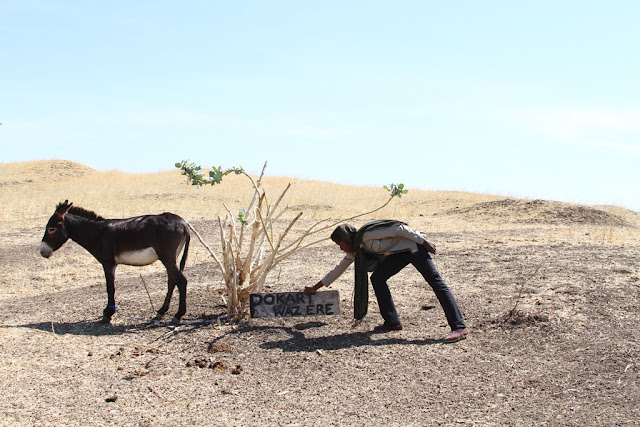 |
| 3I |
3D – Ala taking more photos; there were too many photographers that the nomads had a hard time focusing.
3E – The borders, blurred
3F – Interventors!
3G – Emeka has noted it will be necessary to consider the fact that digital cameras is changing the way photography is experienced, showed and enjoyed. Notice the interest on the faces of some of nomad friends, and notice how Ray is serious about his showcasing job.
3H – I loved the laughter, and the show of expertise
3I – Pokart, here again.
Other Vestiges
Of course, the food. To eat well in a different country, especially with food, I convince myself that the indigenes who eat such food are humans, too. They have glands and kidneys and stomachs. If the food does not hurt them, it will not hurt me too. Unfortunately, we often scanned the menu for food we were familiar with; but our hosts prevailed at some dinners, serving us only Sudanese food – thanks to Rayan, Mohad and Saleyma for the sumptuous dinners (should I add the wine? Yes, thanks to Cage and Mohad. And thanks to Faisal for the extra, which I dare not name.) I think we easily accepted falafel, which when we ate it for the first time, Ray proclaimed it a Sudanese bean cake.
The cheap phone calls. For ten Sudanese pounds I called five people.
Sudden statements that told how tense Sudan was: “If you’re caught with a gun, you’re beaten up before being questioned.” “Sudan is placed on an embargo by most of the world.” Then we added, “Now that America has placed an embargo on Sudan, the Chinese will come in.” Ah, yes, the Chinese are already in, with names like Dong Fang (which incidentally is the name of a big hotel in N’djamena).
Note also that most Sudanese cars are white. I did not bother to ask why.
Khartoum is a city of colourful shop entrances, high houses, and an airport runway beside the highway, so that airplanes seem parked as in a car garage. And there is El-Fatih Tower, a hotel built by Gaddafi, which is the biggest and best in Khartoum. We speculated, “what will happen now that he’s dead?” “It’s probably family business.” “But all of his family members are on the run.”
I implore the interested reader to visit Khartoum and find peculiar vestiges that escaped our view.
 |
| 4A |
 |
| 4B |
4A – Our last meal in Sudan
4B – Stop over at Tooti Island, while we crossed the Nile. The group with Yassir Bukhari and Mohammed El-Toum
Crossing Over
Ethiopia began badly for us – we had to deposit one of our cameras; there was a new policy that made it compulsory for persons moving into Ethiopia to deposit 10% of the total amount of each equipment at the border. Given that at that moment we were short of cash, we negotiated with the Custom officers, and they accepted one of our cameras.
And then, upon getting to Gondar, we decided to travel throughout the night, given reports that the road was safe, and our interest in getting to Addis soon enough. But safety is often unpredictable; our driver reversed the bus when news reached him of the activities of peasant thieves. And our driver sought the help of nearby soldiers. There intervention was helpful – they shot in the air, and then they removed the stones allegedly placed by the peasant thieves as a road blocks.
But, upon entry into Ethiopia through the Goha Tsiyon-Dejen road, we were presented with a breathtaking grandeur, which is certain to last a lifetime – I implore the good reader to consider a bike ride through this terrain, for beauty should be explored (Ala has a bike ride on his 2012 wish list).
 |
| 5A (1) |
 |
| 5A (2) |
 |
| 5B |
 |
| 5C |
 |
| 5D |
 |
| 5E |
 |
| 5F |
 |
| 5G |
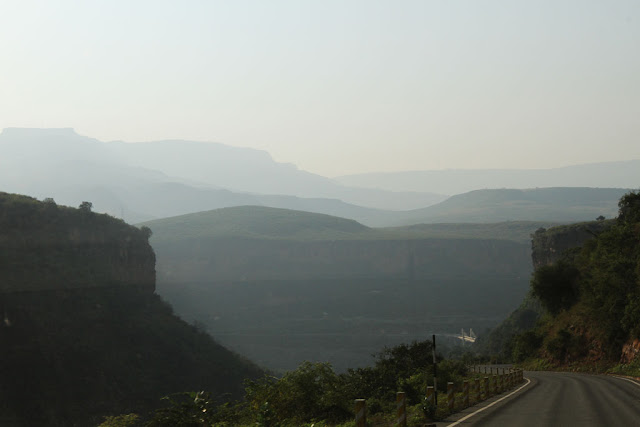 |
| 5H |
 |
| 5I |
5A(1) & (2) – Donkey ride into Gondar, Ethiopia
5B – The kind of search we endured
5C – En route Ethiopia, soldiers muster efforts to attack the peasant thieves.
5D – The stones being removed
5E - Crossing over 1
5F – One of our drivers
5G – Crossing over 2
5H – Crossing over 3
5I – Arrived!
Text: Emmanuel Iduma
Images: Ala Kheir, Ray-Daniels Okeugo, Jumoke Sanwo, Emeka Okereke












































































